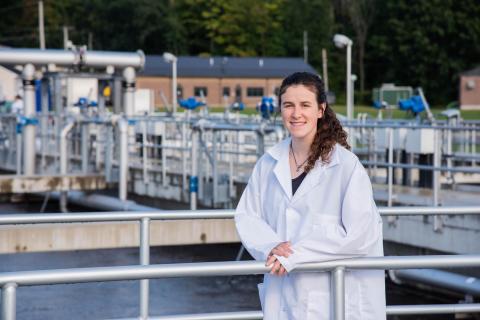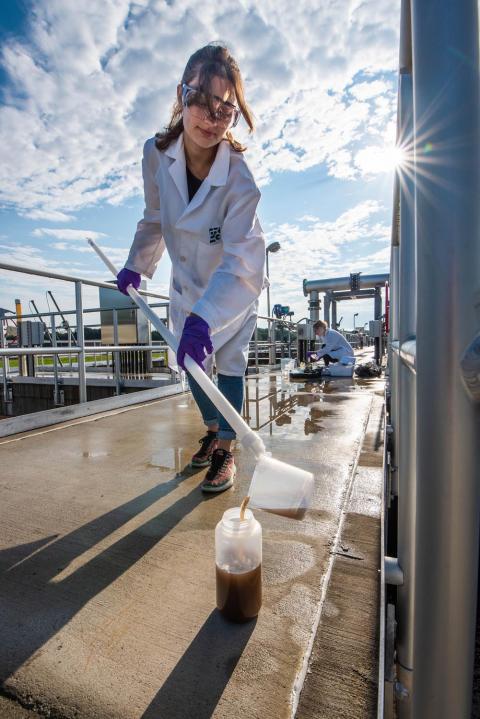Graduate Student Feature: Tracking PFAS in Wastewater

Sydney Adams’ research started with a scary question researchers investigating had about wastewater treatment facilities and PFAS – a class of chemicals used in many common consumer and industrial goods, chemicals we now know can be dangerous to people. In 2000, the US banned the production of two PFAS compounds, specific molecules with a chain of eight carbon molecules, that were proving to be particularly harmful.
According to Adams, who was advised by Paula Mouser in the College of Engineering and Physical Sciences, researchers found that these two compounds are showing up in higher concentrations in the products of wastewater treatment facilities than seemed possible, given the levels in the water flowing into these facilities. Somewhere inside wastewater plants, these dangerous PFAS compounds are increasing. Where are they coming from?
They aren’t introduced or added, researchers found that these longer chains are actually being born from other PFAS with shorter chains of carbon glomming together, transforming into these longer dangerous eight-chain PFAS. After the ban of the eight-chain PFAS, some of these shorter chain compounds replaced the banned PFAS in industrial and consumer applications.
Adams wanted to know how this PFAS combination was happening, and what conditions – temperature, pH, among others – promoted it. If we can find that out, then maybe we can stop these dangerous compounds from being born.
Intercepting PFAS at wastewater treatment facilities makes sense for protecting people, Adams says. “Wastewater treatment facilities are a fantastic last wall between human use and the environment… If we're using PFAS upstream, there's an opportunity for humans to intervene with that water and try to remove it before it enters the environment.”

Adams says wastewater treatment is “such an important piece of our infrastructure in our society, and people still look at wastewater like, ‘gross,’ or right now with the whole PFAS problem, wastewater operators are kind of looked at as the villain as if they’re producing the PFAS. No, they're not. The people are producing the PFAS. [Wastewater Treatment Facilities] are just collecting it.”
Adams explains that because the field of PFAS is so young – PFAS are known as a contaminant of emerging concern and aren’t yet well understood. We don’t yet have the tools to detect all the shorter PFAS replacing the eight-chain worrisome PFAS in products, industries, and eventually in our wastewater.
Adams’ project initially hoped to create a miniature version of a WWTF’s secondary treatment system process which uses bacteria and biological methods to help neutralize contaminants in wastewater. Her experiment morphed over time to instead create microcosms within WWTFs themselves, using semi-permeable dialysis bags to create cocoons for PFAS-laced water, allowing nutrients and water to enter and exit but keeping the PFAS contained. She could then track how the PFAS reacted to temperature, pH, and more.
States like Maine are already looking at limiting PFAS levels in effluent from WWTFs, and this research could be critical to meeting those requirements. “If we can inhibit some transformations before exiting wastewater treatment facility, I think in the future, when a lot of these facilities are being regulated, I think some of that science could help them abide by that.”
Learn more about our graduate fellowships in research, policy, and more.